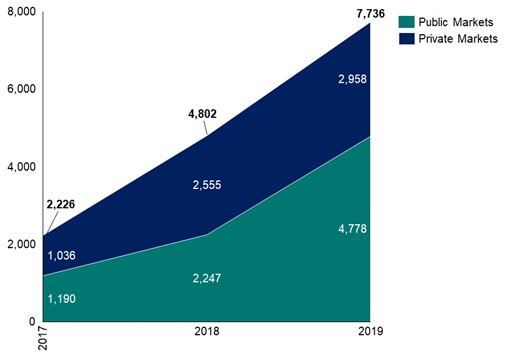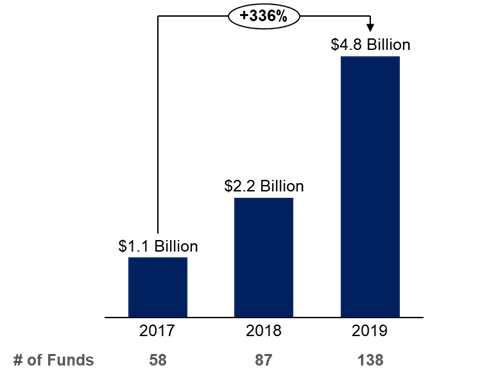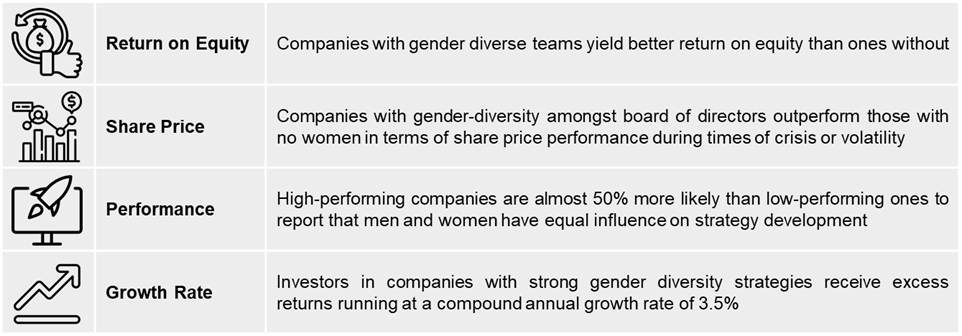
Understanding Gender Lens Investing
Gender Lens or Gender Smart Investing is an approach to mainstream gender factors in business investments to yield higher economic, social, environmental, and return on investment outcomes, mitigate risks and explore new opportunities for investments that create a gender-inclusive environment in investing.
Such investments are made under three major categories:
i. Investing in women-owned or -led enterprises
ii. Investing in enterprises that promote workplace equity and diversity (in staffing, management, boardroom representation, and along their supply chains) and,
iii. Investing in enterprises that offer products or services that substantially improve the lives of women and girls.
The concept of Gender Lens Investment is being adopted by multiple investment entities i.e., asset owners and managers across the world, such as:

Huge investments are being made under this strategy and investment entities have now started analysing the quantum of investments i.e., assets under management that are being held in Gender Lens Investing, both by public and private capital markets. Although the data is still limiting, there is still sufficient evidence to substantiate that Gender Lens Investing has gained traction over the last couple of years.
According to a study done by Sasakawa Peace Foundation, Catalyst at Large and Sagana released in July 2020, there are at least 192 “named”, active gender lens investment vehicles, with a total Asset Under Management (AUM) of US$7.7 billion globally. This has increased by 61% from $ 4.8bn in 2018.

Project Sage, a Wharton Social Impact Initiative with Catalyst at Large, undertook a landscape analysis of over 138 structured private equity, venture capital, and private debt funds with a gender lens. The total capital raised, among firms that allowed us to publish capital raised, was approximately US$4.8 billion in 2019, an increase from US$1.1 billion in 2017, which is further increasing. The same report also highlighted that there is an increase in the diversity of targeted investment geography, with a significant focus on regions including Asia, sub-Saharan Africa, and Latin America.

Further, amongst the surveyed funds, 45% consider gender as one of several key impact priorities of equal importance. Other forms of diversity publicly stated in their investment criteria include racial/ethnic diversity and LGBTQIA diversity.

According to Veris Wealth Partners, a pioneering wealth management firm and a leader in sustainable and impact investing, publicly available Gender Lens Investing products have increased 300 per cent since 2015. Assets under management as of 2019 were estimated at more than US$3.4 billion, up from US$2.4 billion in 2018.
There is also growing evidence that most of such investments are being driven by women investors and millennials, both of which are expected to be major wealth owners in the coming years. Women investors are interested in gender diversity, with 79 per cent wanting to invest in companies that have strong gender diversity policies.
As per Asian Venture Philanthropy Network (AVPN), a comprehensive funders’ network in Asia, with US$1.4 billion investments across 47 investment vehicles, Asia is the second largest region for Gender Lens Investing. Capital invested in Asia has doubled in 2019 with 63 per cent of gender-based investment vehicles being set up in 2018 or 2019.
Importance of Investing in Women
Gender inequality has major costs to the economies since the full potential of the working and consumer population remains untapped when women are not participating in income-generating and spending activities. Globally, countries are losing $160 trillion in wealth because of differences in lifetime earnings between women and men. In 2015, McKinsey & Company stated, if women had the same financial incentives, skills, opportunities, and access to technology enabling them to participate in the labour force as men do global Gross Domestic Product (GDP) could increase by up to 26 per cent i.e., US$ 26 trillion by 2025 . The Sustainable Development Goals (SDG) Index, 2019, stated that until 2030, nearly 40 per cent of the world’s girls and women i.e., 1.4 billion will live in countries failing on gender equality.
The global pandemic COVID-19 has exacerbated gender gaps amongst economies with increased instances of gender-based violence, women’s exit from the workforce, and the over burden of unpaid care work for women, to name a few. There is a need for rebuilding the ecosystem with women in the workforce post the pandemic as the countries try to rebuild their economies. Further, women continue to be dominant purchasers of essential goods and services across economies.
Gender Lens Investing comes with greater opportunities for investors to contribute to economies by unlocking the potential of women as clients and customers and to SDGs by addressing developing challenges, including women’s access to education, employment opportunities, health services, water, sanitation, and reducing gender-based violence.
Economic Relevance of Gender Lens Investing
There is growing evidence on financial returns of Gender Lens Investing. According to Veris Wealth Partners, over 50 per cent of public Gender Lens Investing products focus predominately on women in leadership and increasing gender diversity. The focus on leadership with increased shareholder advocacy efforts to increase board diversity has yielded an impact. In 2009, women comprised 16 per cent of S&P 500 boards which has increased to 26 per cent in 2020.
More than 50 per cent of public GLI investment products focus predominately on women in leadership and increasing gender diversity, according to Veris. This is defined differently with each product strategy, but most often is women on boards, women in the C-suite, and women in management. The focus on leadership, coupled with increasing shareholder advocacy efforts to increase board diversity, have helped. In 2009, women comprised 16 per cent of S&P500 boards, and today they represent 26 per cent. Progress, yet still a lot more work to do.
A study conducted by International Finance Cooperation stated that Private Equity and Venture Capital firms with gender-balanced senior teams delivered between 10 per cent and 20 per cent higher returns than teams with majority male or female leaders . Another study with 21,980 firms from 91 countries, discovered that an increase in women in leadership from zero to 30 per cent correlated with a 15 per cent increase in profitability of the firm .
Broadly speaking, finance metrics i.e., returns and valuation improve with gender-balanced leadership teams.

Gender Lens Investing leverages new opportunities i.e., building on a new customer base and manages risks i.e., gender pay gap and sexual harassment that can harm the reputation, operations, and finances of the organization. It also assists organizations in building their competitiveness in the market for products and human capital since people prefer to work in an inclusive environment.
Challenges in Implementation of Gender Lens Investing
Despite a multitude of benefits from Gender Lens Investing, it is still in a nascent stage and a majority of investors are sceptical of investing in instruments with a gender lens. Some of the reasons for this are:
- Lack of data on returns and impact: The evidence data around the financial returns and subsequent social impact is still not sufficient to catalyse large scale investments from all classes of investors. Some of the new terminology related to Gender Lens Investing has still not been backed by benchmarked data across regions i.e., specific studies have been conducted that give limited insights on financial returns and impact for its instruments. Given the poor availability of high-quality data on gender metrics, there are lower investments even in the public markets.
- Lack of women in leadership positions, including in investment boards: There are still limited number of women in board rooms of large organizations, private equity and venture capital funds which impedes the organization in understanding the need and returns for such investment instruments. Limited women as allocators of capital have slowed the process of such investments. A report by IFC mentioned that women hold only 10 per cent of all senior positions in private equity and venture capital firms globally, and women-led enterprises collected less than 3 per cent of global venture capital in 2017 .
- Cumbersome tools for monitoring and evaluation: Given the complexity of monitoring Gender Lens Investments, it is cumbersome for resource-constrained investment teams which averse them from such investment portfolios. The study by Project Sage, a Wharton Social Impact Initiative with Catalyst at Large, mentioned that investors highlighted that they find that using gender terminology in the areas that they focus on (like childcare, eldercare, workplace innovation) could reinforce stereotypes of women’s role in the society, due to which they refrain from using its terminology publicly .
- Perceptive challenges of investors and markets: There are perceptions that focus on gender factors that lead to the narrowing of the pipeline to have a diverse portfolio. A lack of awareness amongst market actors is prevalent around the risks for not paying enough attention to gender and the inherent opportunities. Another prevalent misconception amongst investors is their belief that Gender Lens Investing-focused funds can only invest in female entrepreneurs, or that there is a lower focus on financial returns.
Recommendations for Integrating Gender Lens Investing in India
To circumvent the above challenges and the other conditional biases towards women, steps must be undertaken to boost Gender Lens Investing.
In India, only a few investors are proactively investing with a gender lens. A study by FSG on Gender Lens Investing in India stated that impact investors in India mentioned that outcomes related to gender are incidental rather than actively pursued. This results in a missed opportunity to increase their returns by deepening the social impact they create for women .
Some of the actions that can integrate Gender Lens Investing in India’s investment portfolio are:
- Leverage networks for the identification of women entrepreneurs and investors: There is a requirement for developing a pool of investors and investees that would undertake Gender Lens Investing. Platforms such as WeConnect, a global network connecting women-owned businesses to qualified buyers, and SheEOs that enables women to pool together their capital, their networks and their ideas could be created for Indian women entrepreneurs and investors and/or for investors interested in investing in India.
- Evidence generation on return and impact of Gender Lens Investing: Gender disaggregated data and data from investor agencies is needed to build a business case for such investments. Studies conducted by IFC, Wharton Social Impact, FSG, to name a few can be referred to, and similar studies that focus on the Indian Gender Lens Investment landscape can be undertaken to understand investors, financial instruments, investees, and risk-return models that have been working. Fund managers can leverage such studies to undertake deal structures and opportunities in the market. This might also break some of the preconceived notions and biases. Gender disaggregated data should also be collected on founders at different levels of the investment pipeline to identify drop-off points and find ways to reduce them.
- Adoption of available gender toolbox for gender equality metrics: A host of agencies have developed gender toolboxes that could be used in measuring gender equality metrics. This would assist fund managers in defining impact indicators and subsequent returns. This would also create awareness amongst investors on the intended and unintended outcomes of Gender Lens Investing. Some of such toolkit examples are: Private Equity and Value Creation: A Fund Manager’s Guide to Gender-smart Investing (IFC and CDC) , Gender Equality Scorecard (SEAF) , 2X Challenge Working Group Reference Guide (2X Challenge) , How to Measure the Gender Impact of Investments (CDC, 2X Challenge, GIIN) , to name a few. These could be tailored to the Indian context and used by investor groups to have a benchmark on the evaluation of outcomes from such investments.
- Public-Private Partnership to boost Gender Lens Investing: Government can institutionalize platforms such as the Social Stock Exchange which consider parameters of gender equality for listed entities and provide for instruments such as Development Impact Bonds that consider strong gender equality impact metrics. The private sector could assist the government in designing platforms, instruments and further, make investments that drive Gender Lens Investments. Corporate Social Responsibility (CSR) funds could be used in building the platform and/or in buying such instruments that prioritise gender equality.
This article has been authored by Guriya.
- https://www.spf.org/en/global-data/user47/GLILandscapeReport.pdf
- https://socialimpact.wharton.upenn.edu/story/project-sage-3-0-key-insights-from-the-latest-gender-lens-investing-report/
- https://www.veriswp.com/gender-lens-investing-assets-grow-to-more-than-3-4-billion/
- https://avpn.asia/webinar/avpn-2020-building-the-case-for-gender-lens-investing-across-asia/
- https://www.worldbank.org/en/news/press-release/2018/05/30/globally-countries-lose-160-trillion-in-wealth-due-to-earnings-gaps-between-women-and-men
- https://www.mckinsey.com/featured-insights/employment-and-growth/how-advancing-womens-equality-can-add-12-trillion-to-global-growth
- https://data.em2030.org/2019-global-report/
- https://www.veriswp.com/gender-lens-investing-assets-grow-to-more-than-3-4-billion/
- https://www.ifc.org/wps/wcm/connect/topics_ext_content/ifc_external_corporate_site/gender+at+ifc/resources/gender-balance-in-emerging-markets
- https://www.ifc.org/wps/wcm/connect/79e641c9-824f-4bd8-9f1c-00579862fed3/Moving+Toward+Gender+Balance+Final_3_22.pdf?MOD=AJPERES&CVID=mCBJFra
- https://socialimpact.wharton.upenn.edu/story/project-sage-3-0-key-insights-from-the-latest-gender-lens-investing-report/
- https://www.spf.org/en/global-data/user47/GLILandscapeReport.pdf
- https://www.fsg.org/blog/investing-in-women
- https://www.ifc.org/wps/wcm/connect/topics_ext_content/ifc_external_corporate_site/gender+at+ifc/resources/gender+smart+investing+guide
- https://www.seaf.com/ges-manual/
- https://static1.squarespace.com/static/5b180402c3c16a6fe0001e45/t/5ef8d17caa257013944d83bc/1593364865863/2XReferenceGuide_Designed_June+25_FINAL.pdf
- https://assets.cdcgroup.com/wp-content/uploads/2020/03/16111901/How-to-measure-the-gender-impact-of-investments.pdf


